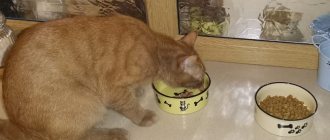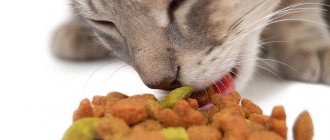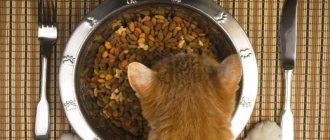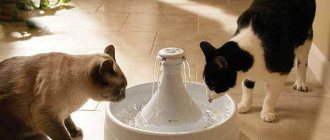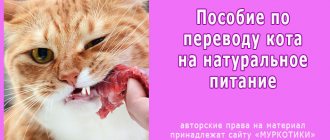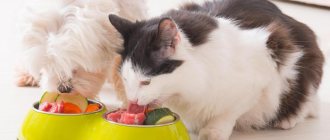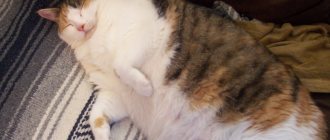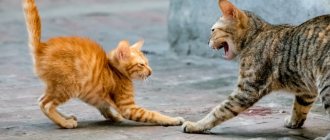When choosing the most optimal way to switch your cat to another food, you should not expect that she will immediately start eating it. Many mustachioed pets are picky eaters, especially at an older age, and suffer from food allergies and other diseases. But no matter for what reason the food changes: whether the kitten is growing up, the usual brand has disappeared from sale or has risen sharply in price, supply interruptions, only a gradual transition will provide a chance for success.
Transfer to natural food
Cats are carnivores by nature, so they need meat.
We feed our pets dry food solely out of laziness. By arranging a comfortable existence for ourselves, we cause irreparable harm to the pet, crippling not only its physical, but sometimes also its mental health.
For this reason, switching a pet to a diet that is normal for a living creature is a whole problem that not every owner can cope with.
Switching to a natural diet is not so easy. Felines are predators and carnivores; soups and porridges are not suitable for them. You need to prepare for the fact that you will have to monitor the balance of nutrition, the freshness of products, their variety, and prepare separately only for a cat.
Cat bowl with budget dry food
Is it possible to switch a cat to dry food from raw meat?
Many owners rightly consider the cat to be an obligate predator and feed it exclusively raw meat and offal. Of course, meat is the best food for a cat, but you should understand that at home it is very difficult to create a balanced diet for your pet, and in addition, raw meat poses some risk in terms of parasites and various bacterial infections. Therefore, it is safer to feed dry food with a high content of meat ingredients, such as Acana and Orijen diets - then the cat will eat as it should, and nothing will threaten its health.
However, in order to correctly switch a cat to dry food from eating raw foods, you need to understand that mixing them with dry food in the same bowl is extremely undesirable. Raw and cooked foods are digested at different rates, and when placed together in the stomach, these ingredients can cause indigestion and even vomiting. Therefore, we begin to offer the cat dry food, first in small quantities, instead of one of the meals (if you feed more than twice a day) or in between them.
You can use dry food granules as a treat at first so that your cat can try the new product and appreciate its smell. If your pet does not show interest in dry food, then we advise you to slightly soak it with water, as we wrote above.
During the entire transition period, monitor the cat’s well-being, monitor its stool and the condition of its fur. In case of any unwanted manifestations, it is best to consult a veterinarian. In general, switching cats to dry food is not very difficult, and soon your pet will be happily crunching on granules. Just remember that the need for liquid with this type of diet increases significantly, so make sure that your pet always has clean, fresh water at his disposal.
Tips for feeding a cat you've recently adopted
Mixing food of different brands or formulations takes some time. Make sure your pet enjoys her meal.
- Prepare a private and quiet area for her to eat, without loud noises or other cats.
- Hand feed her, at least at first. The person offering the food must get along well with the cat.
- Offer wet or canned food along with dry food.
- Make sure you store all feed properly to maintain its quality and freshness.
Rules for replacing one type of feed (industrial) with another (natural)
No matter how you are outraged by the type and composition of the food that the cat was fed by the previous owner, at first you will have to feed it exactly. Until the animal gets comfortable in its new home, this will normally take from two days to a week, depending on its psyche and your behavior.
Just like a person forced to go on a diet, the cat will express dissatisfaction. Cats are excellent manipulators. Do not give in to provocations: eyes full of pleading, an angry meow, and so on. If you decide to change your pet’s diet, be patient
But don’t scold: any change in life, and especially in such an important process as nutrition, is a lot of stress.
The “get hungry and eat whatever” method is bad for your cat’s health. By the way, this method does not always work - even a very hungry animal can refuse completely unfamiliar food.
A painless transition to another type of food will take at least a month, depending on the age and health of the animal.
If your pet eats almost nothing but dry food, you will have to soak it: in the first days, you cannot do without thoroughly mixing the two types of food.
At first, the new product needs to be crushed until smooth.
The following are suitable “substitute products”: good quality cottage cheese without additives, boiled yolk, meat minced twice.
Add one new product to a serving; the next one can be offered no earlier than two days later.
Start with a very small portion of the new product, no more than 5% of the serving. Increase the portion only when you are sure that the cat eats the new version of the usual dish with appetite and it does not cause health problems.
Initially, meat and offal should be lightly boiled or steamed with boiling water, since industrial feed is always heat-treated. Once you are sure that meat dishes are well received by your cat, offer very small pieces of raw meat coated in flour from ground dry food.
It is convenient to mix minced meat with a small amount of vegetables to wet food. How to prepare cat food is written in the article: recipes for natural food for cats.
Don't leave uneaten food in the bowl, even if your cat has just started eating. When she gets hungry, she will eat more at the next feeding.
What about the reverse transition - from natural food to industrial feed? Oh, this event will cause a lot of enthusiasm in the cat. And the lower the food class, the more. Because industrial food contains both taste enhancers and flavors that are attractive to cats.
Even well-fed animals, fed with high-quality raw meat, greedily rush to never-before-seen crackers - as if they had been starving for a week. Nevertheless, the replacement process needs to be extended over a month - in order to avoid health problems, first of all, to prevent allergies and gastrointestinal diseases.
How long will it take to change food?
Ideally, owners who are patient enough have up to ten days to gradually change the cat’s usual food to a new one. In order to injure the animal as little as possible, the transfer is carried out gradually. Initially, in the first days, about 25% of new food is added to the animal’s diet. When, after eating several times, the cat becomes accustomed to the innovation, the amount of new food is increased to 50%. After a week of changing the diet, the new food may well account for three-quarters of the total amount of food.
Thus, day by day increasing the amount of new food, we ensure that the animal switches from its usual food to a new one. However, unfortunately, for many owners of particularly capricious animals, everything does not go so smoothly. What to do in this case?
Sudden change of food for cats. Causes
The causes of diarrhea often depend on the negligence of owners who neglect preventive measures. The occurrence of diarrhea is explained by:
- A sudden change in food or usual feeding. Cats have a hard time switching to another brand. Small kittens left without mother's milk and forced to replace it with cow's or goat's milk often suffer from gastrointestinal disorders.
- By eating waste. Due to their individual characteristics, some cats are not averse to stealing leftover food from the garbage can. Not all spoiled foods have an unpleasant odor or taste, but they still pose a danger.
- Intolerance to medications. Diarrhea in cats is a classic side effect of medication.
- An infection of a bacterial or viral nature. Refusal to vaccinate increases your pet's risk of infection.
- Disorders of the metabolic process, intestinal and oncological diseases of the gastrointestinal tract. These include problems digesting food, inflammation, and damage inside the intestines.
- The presence of foreign objects inside the body. Crumpled wool, buttons, toys and much more interfere with the free movement of feces, causing stool upset.
- Allergic reactions. Most adult cats are lactose intolerant, so it is best not to offer them milk. Some animals, like people, may have intolerance to certain types of meat, fish, gluten or brand of food.
- Excessive consumption of food. Overeating not only leads to obesity, which is complicated by a number of more serious and dangerous diseases, but also interferes with the absorption of fluids.
- Infection with helminths. Adults can be found in cat feces.
- Poisoning. The danger of poisoning lurks not only for those who walk on the street, but also for homebodies. Household chemicals, cosmetics and other hazardous substances are found in any apartment.
- Stressful situations. Any events that disturb the pet can disrupt the functioning of the gastrointestinal tract.
- Postponed surgery. Sterilization, which involves anesthesia, slows down internal processes and leads to diarrhea or constipation.
- Other diseases of internal organs: kidneys;
- pancreas;
- liver;
- thyroid gland (diabetes mellitus).
Disadvantages of dry food in cat nutrition
Industrial feeds are addictive because they contain a large number of additives. Popular brands do not contain essential microelements; their minimal amount does not cover the damage to the digestive system caused by other ingredients. Long-term consumption of dry food leads to diseases of the digestive and genitourinary systems, stomach, and kidneys.
Causes and consequences of an inadequate cat diet
- Reason: High carbohydrate content in the feed. Consequences: Colic, bloating, ulcers, constipation, kidney failure.
- Cause: Insufficient fluid intake. Consequences: Constipation, kidney stones, kidney disease.
- Reason: Flavorings and flavoring additives in food. Consequences: Increased blood sugar levels and diabetes.
To normalize the functioning of internal organs, you need to feed your cat natural food. A change in diet can be temporary or permanent, depending on the veterinarian’s recommendations and the animal’s well-being. The minimum period for alternating food is 3 months. Frequent changes or combined meals will lead to poor health and diarrhea.
The cat is sick
Pets, just like people, suffer from serious illnesses. Some diseases accompany the pet throughout its life. Diseases such as diabetes, pancreatitis, and kidney failure require constant attention. For such animals it is very important to eat properly.
Consult your veterinarian. He will select food that will help your pet live a full, healthy life.
Important rules for transferring a pet to dry food from other types of food
When switching a cat to another type of food, you must follow several important rules:
- Taking into account the needs of the pet. The cat's preferences should be taken into account before offering another food. If your pet is a big fan of chicken, then it is unlikely that he will eat meat crackers. But indicating the type of meat on the package is not an advertising ploy, as many people think. A self-respecting manufacturer provides truthful information, which cannot be said about budget food. They use flavorings that are identical to natural ones. In addition, high-class industrial food is initially designed for the specific needs of the pet: to facilitate the removal of hairballs, for sterilized cats, for active cats. You should immediately take these nuances into account so that your pet receives a diet that suits its needs.
- Gradual means a gentle introduction of industrial feed into the diet.
A sudden change is harmful and even destructive. It is enough to replace 1/10 of the usual portion with “crackers” and increase it daily by 1/10. Every day you should replace only 1/10 of your pet’s usual diet with dry food. - Time. The transfer from one type of feed to another should be carried out within 10–14 days. During this time, the cat will already taste new food. After this time, only the industrial product should be in the bowl.
- Unobstructed access to water. This is the most important rule when feeding commercial food.
The nuances of switching to dry food from different diets
Depending on what the cat ate previously, there are some nuances when switching it to dry food.
From wet industrial food
If the cat ate canned food, that is, wet industrial food, then everything is simple. In the first 2-3 days, crackers must be pre-soaked to the desired consistency. Gradually, soaking can be replaced with light moistening with the sauce from these canned foods. That is, mix the granules into a bowl, let it brew, and then offer it to the cat. At the last step, you can simply stir in either just the sauce or just the pieces. And after complete adaptation, leave only dry food.
From natural homemade food
The same rule applies here as with wet food. But cats are very suspicious animals and can easily recognize deception. Experts recommend starting with mixing canned food into natural food, and only then switching from wet industrial food to dry food. By the way, it will take the same amount of time: about two weeks.
There is another, simpler way: offer a dry food pellet as a treat. And specifically for a hungry pet. If no problems arise, then pour the food into the bowl during feeding hours.
My mother decided to switch her cat to dry food. I bought him a pack of Royal Canin. But the pet did not appreciate the taste or smell of the new food at all - he simply buried it with his paw, twitched his tail and walked away. Mom tried to soak it and mix it in, but the cat had no intention of even trying the new treat. Then they bought him a banal “Friskies”. It was he who ate him by both cheeks. But, of course, you can’t feed an animal with this product all the time. The next experiment was with Purina Van food. It fit perfectly too. And finally, the final product in this chain was Purina ProPlan food. Both the owner and the pet settled on it; it suits them in all respects. So if your cat refuses dry food, he may simply not like the taste or smell of this product. And never buy large packs of expensive food at once - there is a chance that you will have to feed it to street cats.
In case of partial replacement of other feeds with dry food
Many cats are not particularly mischievous and happily eat both wet and dry food. This is quite normal, especially if there is only one manufacturer. As a rule, problems with replacement do not arise here. The owner should only strictly decide at what hours he feeds dry food and at what hours he feeds wet food.
How to wean a cat off wet food
The principles of weaning a cat off wet food are the same as in the cases discussed above:
- subsequence;
- phasing;
- monitoring how the animal tolerates new food.
A transfer from feeding wet canned food to “drying” can be caused by:
- veterinarian recommendations;
- The desire of the owners to improve the quality of the animal’s nutrition by switching the pet to super-premium food or “holistic food”.
The complete translation may take several weeks. First, the cat is offered dry granules soaked in water so that the animal becomes familiar with a new type of food. New food should be offered when the animal is hungry. A cat that has eaten its usual diet may not show interest in unusual food.
Further, the granules are offered in dry form; cats usually like the crunchy texture of this food and crunch with pleasure. For some pets, the new taste and texture may seem too unusual - they will refuse to “dry”. Don't worry about this, give your cat time to get acquainted and get used to the new food.
Useful tips
- Carefully monitor the animal's reaction, make sure that the cat eats, do not allow a complete hunger strike - this is dangerous for the liver.
- Feed by the hour. At the initial stage, you should not pour food into a bowl and keep it there all day. Give out food in portions at strictly prescribed times.
- Be patient, don't rush your cat, reward him every time he agrees to try a new food.
Make sure your cat has 24/7 access to clean, fresh drinking water. Animals on a dry diet must receive sufficient fluid.
Video
Step-by-step rule for switching to another food
How to properly switch a cat to another food? Switching to a new food for an animal is always stressful. How to do this correctly without harming the animal?
The most effective translation technique
The procedure for replacing food is extremely simple. Ideally, about ten days should be enough for the transition, during which you will slowly accustom your cat to the new food. In the first days, we add 25% of the new diet to the old diet. If everything goes smoothly, then we gradually increase the ratio to 50/50. At the last stage, you can give 3 quarters of the new food. And so on until the bitter end. If this period drags on or, worse, the purring bandit completely decides to ignore your efforts, then you should resort to more radical measures.
We take starvation or beneficial fasting
If a smooth replacement does not work out: your cat eats up the granules of the old food and leaves the new one in the bowl, or flatly refuses to approach the food in principle, then you will have to starve it out. The most effective way is to give your cat preventative fasting. And no, we are not monsters or sadists: this is not done with the goal of torturing the pet, but for the sake of his health.
Remind yourself often that cats, especially indoor and sterilized ones, even benefit from fasting fasting days - they will help control the problem of excess weight.
The essence of the procedure is simple: you remove the bowl for a day and do not give the cat anything to eat (even if he really asks and is offended), and the next day you put a bowl with new food. Many advise not to embarrass the animal and not to stand around the bowl with the whole family waiting for a miracle - a proud tailed cat may not like public admission of defeat in the war for food, which can only prolong the procedure for transferring the cat to a new type of food.
In the end, the result is the same - your pet will carefree eat the new food, despite the fact that before this he showed fierce hatred and disapproval in every possible way. The only thing is that when switching to a new diet (especially if this is done for reasons of economy), you should not ignore the issue of quality.
- Firstly, the diet should contain a lot of meat, because the cat is a predator.
- Secondly, look for probiotics in the composition, they will help with digestion. Phytocomponents (fennel, Yucca Schidigera) will help eliminate toxins, and the vitamin-mineral complex will provide your animal with the correct ratio of microelements. In this vein, the line of cat food from Blitz shows itself very well, where diets with chicken, dietary turkey and hypoallergenic lamb are presented.
What else is important?
Even if you are switching your pet to a different diet for financial reasons, you cannot ignore the issue of quality. The diet of a carnivorous (domestic cat is a predator) animal must contain meat, which means the food must contain it. In addition, good food often contains probiotics, which are essential for the smooth functioning of a cat’s digestion, phytocomponents that help remove toxins, vitamins and minerals that help maintain the health of internal organs, softness and a healthy shine of the coat.
In the online store “World of Tails” you can choose the right food for your favorite cat; we offer a large selection of food for kittens, adult and elderly cats, from high-quality economy-class products to premium brands. The pet store offers brands Pro Plan, Royal Canin, Hill's, Trainer, Farmina and many other brands recommended by experts. In the catalog you will also find special food: veterinary, hypoallergenic and dietary food.
Switching from wet food
Wet food is not a natural product, but it is moister and more flavorful. Canned meat is considered the best option for the transition. Their aroma is slightly weaker than that of dry food, but is also attractive to the cat. You need to start with a gradual substitution. Reduce the amount of pellets, increase the volume of wet food portions. At some point, remove the dry food altogether and feed a little canned food only.
Introduce natural foods into your diet one by one. Start with flavorful meats, healthy vegetables and cereals. Think through everything in advance so that the animal receives the right amount of vitamins and nutrients. The size and shape of regular food pieces should resemble canned food. Over time, begin to reduce the amount of wet food. Here the scheme is similar to the very beginning of weaning. This method allows you to loyally wean your cat off dry food in 1-2 months.
The cat is expecting offspring, or feeding milk
If your cat is expecting offspring, then you need to change her food. Since bearing kittens is a big burden on the body, the cat needs microelements and vitamins so that the kittens are born healthy and strong. The best option would be to switch to kitten food. It is nutritious and contains more fats and carbohydrates. Since the cat's appetite will increase, the amount of food given at a time should be increased. Ideally, your cat should be fed small, frequent meals.
You have noticed that your cat is quickly gaining excess weight, do not worry, this is the norm for pregnant animals. The fat layer is necessary for bearing kittens.
As soon as the offspring are born, the cat will begin to feed them milk; veterinarians recommend adding water to the food, since a nursing cat needs more liquid.
After 8 weeks of milk feeding, you can begin to gradually transition the cat to the old diet.
For an ideal, and most importantly healthy diet, add a little wet food to your dry food. This will make it more balanced.
Transferring the cat to new food and vitamins
A furry pet that appears in the house very quickly becomes a member of the family. And, of course, I want him to be healthy and delight his family with his purring for as long as possible. Each owner chooses for himself how and what to feed his cat.
But there are situations when, for one reason or another, you have to switch your cat to a new food. First, let's figure out why there may be a need to change your diet.
The reasons for switching a cat to a new food can be very diverse. Let's look at the main ones. 1. Age of the cat.
A kitten, an adult and an older animal need different amounts of nutrients. Kittens move a lot and grow quickly, but in an older pet, activity, on the contrary, decreases. Accordingly, feed should be selected taking into account the age and energy costs of the animal. 2. Pregnancy and feeding period in a cat.
During this period, your pet needs more vitamins and minerals, as well as more calories. 3. Obesity or underweight.
In this situation, it is necessary to adjust the caloric content of food, the amount of food consumed by the animal, or transfer the pet to special food that can solve weight problems.
4. Castration and sterilization.
Having lost one of its basic instincts, the cat directs its interest towards food and rest, and the cat’s activity decreases sharply. Moreover, there is a pattern between castration and an increased risk of developing urolithiasis in cats; therefore, it is recommended to switch your furry cat to a special diet for castrated and sterilized cats.
6. Previous operations on internal organs and digestive organs. After surgery, it may be difficult for the animal’s body to digest its usual food. In this regard, it is worth considering the option of transferring your pet to a special diet until complete rehabilitation.
Transferring the cat to a new diet
You need to gradually switch your cat to a new diet, replacing one food with another, since a sudden change in food can have an extremely negative impact on the health and quality of life of your pet. It is best to change your diet over 10 to 15 days.
In the first 3 - 5 days we give approximately 75% of the old food and about 25% of the new. Over the next 3 to 5 days, old and new food should be given equally. Then for another 3-5 days we feed in the proportion of 25% of the old diet and 75% of the new food.
And only then do we completely switch the cat to a new food.
We give old and new food at different times of the day. It is highly not recommended to mix different types of feed, as this increases the load on the kidneys. You also cannot mix different types of diet. For example, you can’t feed him natural food in the morning and dry food in the evening.
A faster transition of a cat from one food to another is allowed only if these foods belong to the same line or the same manufacturer and are similar in composition.
In emergency cases, a quick transition can be made if the pet’s health requires it, but this should only be done after consulting with a veterinarian. A cat and a cat have paralysis and atony of the bladder
What consequences can a cat experience when changing its diet?
It’s worth saying right away that if negative side effects occur when introducing a new food, you need to immediately remove it from your pet’s menu. 1. Since cats have a very sensitive digestive system, you may encounter various negative reactions. Diarrhea or, less commonly, vomiting may occur. 2.
Various allergic reactions may also appear in the form of skin rashes, hair loss and dullness, and purulent eyes.
3. Complete lack of interest in new food. A cat can go on a hunger strike for several days and not even go near the bowl.
Or, on the contrary, an increase in appetite, when your pet will literally sweep food off the plate and diligently demand more.
Scabies disease in cats
Cat disease eczema
American wirehair cat
Choosing a cat
About cats and for cats
As you can see, the process of changing your cat's diet is not as simple as it might seem at first glance.
Sometimes you have to go through several different manufacturers and try a lot of food before you can choose the one that suits your cat.
But after completing this labor-intensive procedure, your pet will delight you with its grateful purring for many years.
Feed requirements
When choosing a new type of food for your domestic cat, you must adhere to the following requirements:
- composition and calorie content. The composition of new food products should include all micro- and macroelements, as well as vitamins that an animal of a particular age needs for growth and development;
- manufacturer. It is better to give preference only to well-known and time-tested manufacturers;
- shelf life;
- price. The owner should be able to purchase a new food format.
These are the basic requirements, but there are also additional ones (for example, taking into account the pet’s health status, individual intolerance to certain nutritional components, etc.).
Why switch your dog to another food?
The decision to change the diet can be made either independently by an experienced and attentive dog breeder, or by a veterinarian.
The main reasons when there is a need to switch to another dry food are most often:
- suspicions of allergies, as evidenced by constant scratching and skin problems;
- excess or underweight (subject to optimal portion sizes and normal physical activity);
- loss of shine of the coat, its slight loss;
- lethargy, lack of interest in games, long walks;
- diarrhea and vomiting, constantly or at regular intervals, occurring shortly after feeding;
- features of physiology: age, illness.
If you doubt your knowledge of nutrition, contact your veterinarian to create a menu
If you are thinking about how to properly create a nutrition plan when switching your dog to dry food, it is best to do it as directed and under the supervision of a veterinarian. The doctor will be able to identify the reasons for the pet’s problems. He will recommend the most optimal type of food, which, depending on the pet’s condition and its problem, can be natural, canned or dry.
Consequences of feeding dry food
Many owners prefer store-bought dry food, based on various assumptions. First of all, it's convenient. Just buy a package at the store and add it to your cat’s bowl from time to time. Secondly, there is an opinion that the components of dry food are as balanced as possible and contain all the necessary components for life.
Unfortunately, this is not always true. Even the most expensive elite food does not consist entirely of meat or fish. What can we say about cheap analogues, which consist of 70-80% food waste, soy or vegetable residues.
The opinions of experts differ one way or another, cat owners are perplexed, and the pets themselves can easily get indigestion. Let's consider a number of ailments that can result from excessive feeding of dry food:
- vitamin deficiency – not all foods contain the necessary vitamins and microelements. You should carefully study the composition of the product before purchasing.
- food poisoning with dyes - the food must be plain without multi-colored granules.
- diseases of the urinary system - salt in feed is used as a preservative, which with prolonged use leads to kidney problems
- allergic reactions - possible hair loss, purulent formations in the mouth and other malignant formations.
All points together lead to heart disease, problems with the digestive organs and general deterioration of health.
Obesity
Obese cats become frequent patients in veterinary clinics. And recently their number has been growing. Compassionate owners pour food for the animal based on their own observations or desires. It is especially often transmitted by cats receiving dry food. Visually, it seems to the owner that the portion is too small or that they are giving additional food from their table. In addition to obesity, such animals have a number of pathologies in their internal organs. To prevent this, it is necessary to observe both the dosage and feeding regimen. Veterinary nutritionists select food based on the individual characteristics of the patient.
What are artificial feeds?
There is also plenty written and said about artificial food for cats today. But basically this is a discussion about which food is better: premium or economy class? What is cheaper and what do cats eat better? The question of whether a cat needs to be fed artificial food at all is rarely raised.
Mostly canned food and dry food for cats are bought because we are lazy. Yes, yes, let's call a spade a spade. First of all, we take care of ourselves. When purchasing artificial food, we don’t bother ourselves with the question “what to give the cat for dinner.” I bought canned food, opened it, poured it into a bowl - and that’s it. Minimum expenditure of thought processes and time.
Natural food is healthier than artificial food.
Advertising of food also greatly contributed to their popularity and somewhat distorted our understanding of a cat’s diet. It is thanks to advertising that we know for certain that cats simply “need” cereals and other silage. But let me remind you that a cat is a carnivorous predator, which by definition cannot become a vegetarian.
In order to understand what ready-made food should consist of, you can remember what the menu of a cat in the village consists of (as close as possible to natural conditions). These are mainly small rodents, less often birds, and even less often fish and insects (moths and grasshoppers). All this is divided into:
- meat - animal proteins;
- bones and skin - calcium and phosphorus.
All that is contained in the victim's stomach is plant fibers and grains. Separately, cats eat grass occasionally for reasons of maintaining their health.
Cats do not eat fermented milk products on their own. Only as kittens in their cat childhood, and if a person allows it. Raw milk in the stomach of an adult cat almost immediately curdles and is not digested.
What follows from all of the above? The fact is that ideally the food should contain all these ingredients in natural proportions. Namely:
- meat – 45%;
- animal protein (egg or milk) – 20%;
- entrails, bones, offal – 10%;
- vegetable components (vegetables, cereals) – 20%;
- the rest is natural mineral supplements and vitamins – another 5%.
But, unfortunately, there are no ideal feeds. They would be too expensive and unprofitable to produce.
So what are we (or rather cats) offered as cheaper food to produce? In order not to be unfounded, we simply read what is written in small letters on a can or bag of food:
- chemical preservatives, sugar substitutes and antioxidants (you can’t live without them);
- by-products (good in principle, but who can guarantee that blood or feather meal, tails, sinews and other waste from slaughterhouses do not go there);
- dyes, flavor enhancers;
- fillers (cellulose, soy, starch).
If the presence of chemical components is at the very least reflected on labels, then with by-products and fillers it is somewhat more complicated. The legislation of many countries does not say at all that the manufacturing company is obliged to indicate a complete list of what is included in the by-products. And no one knows what may be hidden under this formulation.
Cats eat all of the budget line food with by-products of “plant and animal origin” with great appetite due to the presence of generously sprinkled flavoring additives. It’s hardly worth talking about their usefulness. Quite the contrary.
Cats get hooked on artificial food and then not only do they not eat anything other than dry food, but they also often have health problems:
- then the metabolism is disturbed, and cats become fat before our eyes;
- then tumors develop out of the blue;
- or even some British Vicomte de Bragelonne suddenly dies from liver or kidney failure due to many years of excessive consumption of food.
No dry food - a radical method
There are 4 main stages of transition:
Preparation - natural and dry food are mixed, with a minimum amount of granules. This nutrition system lasts for 2-3 days. Adding biological additives
To stimulate the gastrointestinal tract, vitamins are added to food to stimulate the digestive system. Cleaning up dry food - you can’t hide it, it’s important to completely remove the food from the house so that the cat doesn’t smell or hear the familiar rustling sound. Donate food to pet-loving neighbors or feed homeless animals. No concessions - the cat may refuse to eat for several days, but he will not be able to starve himself and will begin to eat unusual food
You should not succumb to your pet’s “provocations,” as he will quickly understand how he can get his usual food.
The period of adaptation is 3-14 days.
Patience comes first
The first thing you need to do is be patient. All members of the cat family have an innate cunning that they will certainly use to sabotage your plans for replacing food. First of all, you will find a trick with “burying”, which clearly compares the new diet with litter for the tray.
Let’s not forget the pained expression on his face, sad glances and heart-rending meows - your pet will do everything to evoke pity and create the impression of a creature dying of hunger. But you can’t give in to provocations! Reluctantly, we stand our ground!
Here we will immediately make a reservation that all owners love their cats. But love is not only about pampering and caresses, but also about the need to sometimes make difficult decisions and take responsibility. What food to switch your cat to and when is just such a case.
